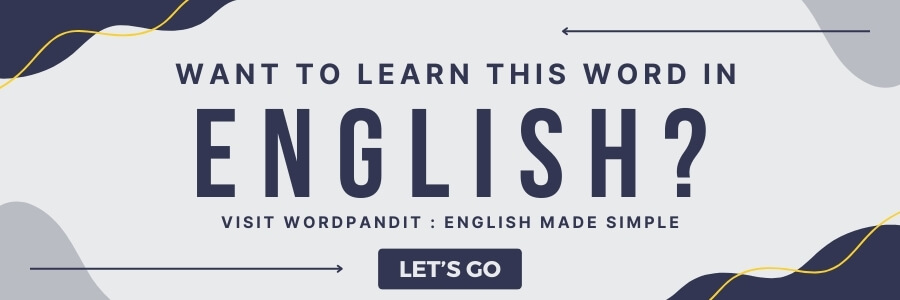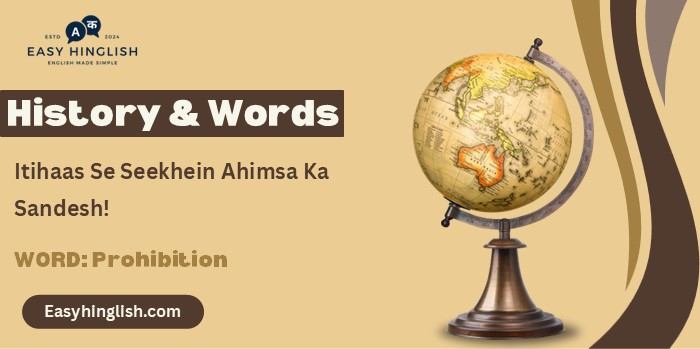History & Words: 'Prohibition' (December 5)
Welcome to 'History & Words.' 🌟 Main Prashant hoon, Wordpandit aur Learning Inc. Network ka sansthapak. Yeh series meri bhasha seekhne ki lagan aur itihas ke prati ruchi ka sangam hai. Har kadi ek shabd aur uss se judi ek tithi par roshni daalti hai, jisse aapka shabdkosh badhta hai aur aap itihas ko gehraai se samajh paate hain. Aaiye, iss safar mein shabdon ke madhyam se samay mein pichhe chalein.
📚 Table of Contents
🔍 Word of the Day / Aaj ka Shabd: Prohibition
Pronunciation: /ˌprəʊɪˈbɪʃən/ (proh-uh-BISH-uhn)
🌍 Parichay (Introduction)
5 December 1933 ko American history mein ek extraordinary moment aaya jab 21st Amendment ratify ho gaya aur Prohibition officially end ho gaya. Yeh sirf ek legal change nahi tha – yeh America ka acknowledgment tha ki "Noble Experiment" fail ho gaya hai. Iss din Utah 36th state ban kar constitutional requirement complete kiya, aur alcohol phir se legal ho gaya.
Prohibition ka end constitutional history mein unique hai kyunki yeh pehla aur akhiri amendment hai jo kisi previous amendment ko completely repeal karta hai. 18th Amendment (1919) ne alcohol ban kiya tha, lekin 21st Amendment ne uss decision ko reverse kar diya. Yeh democratic process ka perfect example tha – mistake ko recognize kar ke correct karna.
Iss moment ka significance yeh tha ki American society ne realize kiya ki moral legislation aur personal freedom ke beech balance zaroori hai. Prohibition era ne organized crime, corruption, aur social hypocrisy create kiya tha. 5 December 1933 ko America ne pragmatic approach choose kiya idealistic rigidity ke upar.
🌱 Shabd ka Utpatti (Etymology)
"Prohibition" Latin word "prohibere" se aaya hai, jiska meaning hai "to hold before" ya "to prevent." Yeh "pro" (before) aur "habere" (to hold/have) ka combination hai. Originally iska matlab tha "to forbid by authority" ya "to prevent by law."
14th century mein English mein yeh word legal contexts mein use hone laga. 19th century mein temperance movement ke saath "prohibition" specifically alcohol banning ka synonym ban gaya. American English mein "The Prohibition" capital letters ke saath 1920–1933 ke era ko refer karta hai.
📖 Mahatvapurn Shabdavali (Key Vocabulary)
- 🔑 Temperance Movement: Alcohol consumption reduce ya eliminate karne ki social campaign
- 🔑 Bootlegger: Illegal alcohol manufacture aur distribution karne wala person
- 🔑 Speakeasy: Prohibition era mein secret bars aur clubs
- 🔑 Moonshine: Illegally distilled alcohol, usually high-proof
- 🔑 Ratification: Constitutional amendment ko officially approve karne ki process
🏛️ Itihasik Sandarbh (Historical Context)
Prohibition ka concept ancient civilizations mein bhi exist karta tha. Islamic law mein alcohol prohibition clear hai, aur Buddhist traditions mein bhi alcohol consumption discouraged hai. Colonial America mein Puritan communities ne often alcohol restrictions impose kiye the.
19th century mein Industrial Revolution ke saath temperance movement gain momentum kiya. Women's Christian Temperance Union (1874) aur Anti-Saloon League (1893) powerful organizations the jo alcohol ko social problems ka root cause mante the. World War I ne grain conservation ke naam par alcohol production ko further restrict kiya.
18th Amendment (1919) aur Volstead Act (1920) ne alcohol production, distribution, aur sales completely ban kar diya. Lekin consumption technically illegal nahi tha – ek legal loophole jo underground market create karta tha.
Prohibition era mein organized crime exponentially grow hua. Al Capone, Lucky Luciano, aur Dutch Schultz jaise figures bootlegging empires build kiye. Chicago, New York, aur Detroit mein gang wars common ho gaye. Law enforcement corrupt ho gaya kyunki illegal alcohol trade mein massive profits the.

⏳ Samayrekha (Timeline)
- 1851: Maine pehla state jisne statewide prohibition implement kiya
- 1919: 18th Amendment ratified (Prohibition begins)
- 1920: Volstead Act enforce, alcohol production stops
- 1929: St. Valentine's Day Massacre (gang violence peak)
- 1932: Franklin D. Roosevelt prohibition repeal promise karta hai
- 5 December 1933: 21st Amendment ratified (Prohibition ends)
- 1933: Legal alcohol sales resume immediately
- 1966: Mississippi, last state to end prohibition
🌟 Is Din ka Mahatva (The Day's Significance)
5 December 1933 ka din American democracy ka flexibility aur self-correction demonstrate karta hai. Utah ka 36th vote history mein ek turning point tha. 3:32 PM par jab Utah's ratifying convention ne vote kiya, toh entire nation celebrate karne laga.
Franklin D. Roosevelt ne 1932 election mein prohibition repeal ka promise kiya tha, jo New Deal ka part tha. Great Depression ke time alcohol tax revenue ki need thi, aur illegal alcohol trade se legitimate business mein shift karna economically sensible tha.
Pauline Sabin ne Women's Organization for National Prohibition Reform lead kiya, jo male-dominated repeal movement ko women's perspective diya. Unka argument tha ki prohibition actually drinking problem worse kar raha hai, better nahi.
Ratification process remarkably fast tha – 21st Amendment ko sirf 286 days lage, jo constitutional history mein record hai. State conventions ke through ratification popular support ko clearly demonstrate karta tha.
💬 Prasiddh Ukti (Quote)
"I believe that the repeal of the Eighteenth Amendment would be a recognition of the impossible – that no law will be respected or enforced if it runs counter to the economic interest or moral convictions of a majority of the people." — Franklin D. Roosevelt
🔮 Aaj Ka Matlab aur Chintan (Modern Usage and Reflection)
Aaj "prohibition" ka usage broader policy contexts mein hota hai. Drug prohibition, smoking bans, aur various social restrictions discuss karte time yeh word use hota hai. Policy makers American Prohibition ko cautionary tale ke roop mein reference karte hain.
War on Drugs mein prohibition model ke effectiveness par debate continue hai. Cannabis legalization movements often alcohol prohibition ka example use karte hain. Public health policies mein prohibition vs. regulation ka debate ongoing hai.
🏛️ Virast (Legacy)
Prohibition ka end modern American drinking culture shape karta hai. Cocktail culture prohibition era mein develop hui jab bartenders strong alcohol taste ko mask karne ke liye mixed drinks banate the. Speakeasy culture aaj bhi trendy bars mein nostalgically recreate hota hai.
Organized crime ka jo infrastructure prohibition mein develop hua, woh other illegal activities mein continue raha. Federal law enforcement capabilities jo prohibition enforcement ke liye develop hui, woh modern FBI aur DEA ka foundation bani.
🔍 Tulnatmak Vishleshan (Comparative Analysis)
1920 mein prohibition ko moral victory samjha gaya tha. 1933 mein practical failure acknowledge kiya gaya. Idealism vs. realism ka yeh classic example hai. Pehle government ko moral authority samjha jaata tha, baad mein practical governance prioritize hui.
Enforcement mechanism bhi change hui. 1920s mein federal agents individual bootleggers ko target karte the. Aaj alcohol regulation taxation aur licensing ke through hota hai, prohibition ke through nahi.
💡 Kya Aapko Pata Hai? (Did You Know?)
🎓 Antim Vichar (Conclusion)
5 December 1933 ko Prohibition ka end American pragmatism ki victory tha moral absolutism ke upar. Yeh din constitutional flexibility aur democratic responsiveness demonstrate karta hai. "Noble Experiment" fail hua, lekin democratic institutions ne course correction successfully kiya.
Prohibition ki legacy modern policy debates mein relevant hai. Yeh remind karta hai ki well-intentioned laws bhi unintended consequences create kar sakte hain, aur public support ke bina enforcement nearly impossible hai.
📚 Aage Padhne ke Liye (Further Reading)
- 📘 Last Call: The Rise and Fall of Prohibition – Daniel Okrent
- 📗 Prohibition: A Concise History – W.J. Rorabaugh
- 📙 The War on Alcohol: Prohibition and the Rise of the American State – Lisa McGirr








